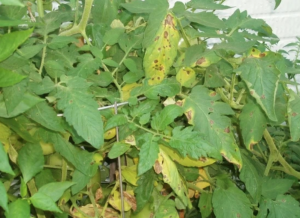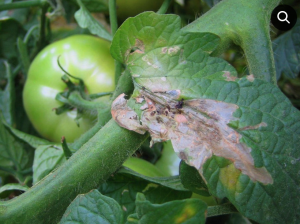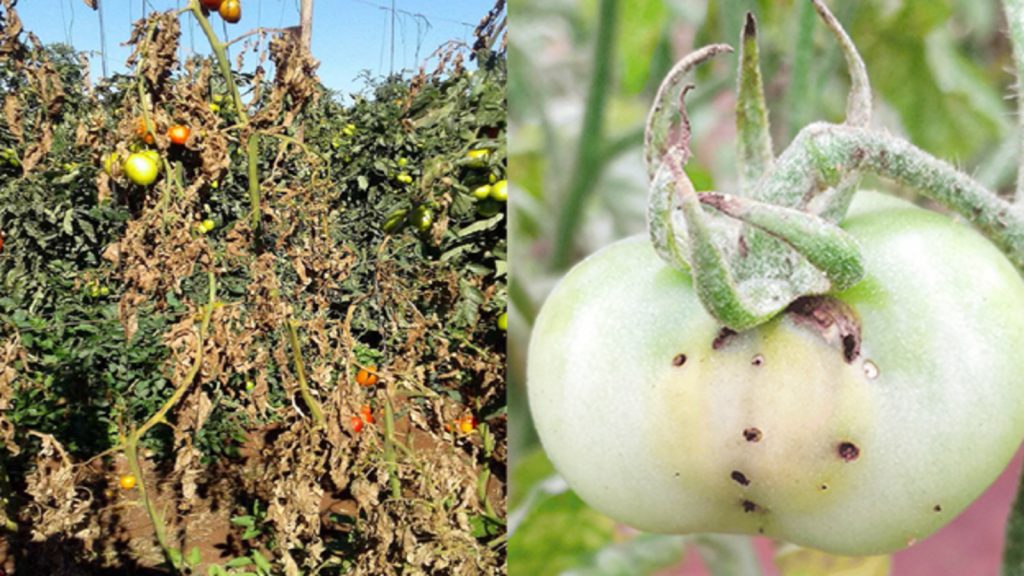Tomato is one of the most important vegetable grown in the country after kale and cabbages and is widely consumed in Kenya. You are most likely to find it at every meal time in every homestead whether fresh as salads or cooked. It can also be processed into paste, juice, sauce etc. Above all, tomato is nutritious and is rich in Vitamin A and C. In addition, it contains properties (food component known as lycopene) that can slow down prostate cancer.
Tomato varieties
On the other hand, it is easy to do tomato farming though it is a capital and labor intensive agricultural activity due to pest and disease management. It can be grown both outdoor (open fields) and indoor (green houses). There are many varieties in the market including Kilele F1, The Star 9068, Nyota F1, Beauty, Marglobe, M-82, Cal-J, Mavuno, Money Maker, Shanty F1, DRD 8551 F1 among others. It also comes in different sizes, colors, shape and weight. In most cases the choice of variety is dependent on the fruit yield per acre, resistance to disease, growth conditions (open field or green house), seeds manufacturer among others.
Incidentally, tomato farming does not require lot of rainfall. However it requires a lot of water to fruit. Ideally this condition is achievable through irrigation and under green houses. Different varieties grow in different areas. Tomato farming areas include Narok, Kajiado, Mwea, Subukia, Machakos, Makueni Loitoktok and many others.
To be successful in tomato farming, ensure the soil is deep and well drained, choose high yielding and diseases resistant varieties, scout (early) for diseases, control diseases and stake properly. Seeds propagation can be done by the farmer or the seedlings bought from certified seeds propagating companies.
Tomato prefers being transplanted hence the need to grow it from seedling with a spacing of 45cm by 60cm. The hole should be 6 inches deep. Watering should be done well after firmly placing the seedling in to the hole. Make sure to spray a fungicide to prevent the roots being attacked by a fungus before transplanting and a pesticide for pest control. This is because the plant is being introduced to a new environment. After a week spray a After 4 weeks fertilizer should be applied accordingly accompanied by watering. {We will cover nutrition in our next article}. Early scouting and use of agro chemicals as a way of pest and diseases management is important as tomato is susceptible to early and late blight, mildew, red spider, tuta absoluta and other diseases.
Likewise weeding should be done to stop weeds from competing for nutrients with the plants.
Basically tomato should be ready for harvesting any time after 2 ½ months depending on variety and plant management. It is highly perishable and the need to reach the market quickly cannot be over emphasized to reduce post – harvest losses. An acre can produce approximately 35 tonnes of tomato if proper farming practices and plant management are adhered to.
Common Diseases in tomato farming
Early blight
Early blight is primarily caused by fungus Alternaria linariae. Tomato is the crop mostly affected by early blight. It affects the fruit, leaves and stem. Early blight is spread by rain, irrigation, insects and garden tools. High temperatures and wet humid conditions promote its spread. Symptoms of early blight do occur on the foliage, fruit and stem.

Characteristics
- Firstly, small brownish/black spots develop on lower leaves, surrounding area may turn yellow, as the disease progresses the leaf turns yellow
- Fruit becomes infected around stem attachment
- Fruit spots are black, infected fruit may drop from plant
- Spores on lesions on any part of the plant
- Severely infected leaves turn brown and fall off or dead dried leaves may cling to the stem
- Ensure proper management and control of early blight by, early detection, planting tomato varieties that offer some resistance to early blight, buying certified seeds, proper spacing for air circulation, spraying fungicides, crop rotation, cleaning up plant residues/debris
Tomatoes that have early blight require immediate attention before the disease takes over the plants. Thoroughly spray the plant (bottoms of leaves also). When treating, apply copper-based fungicides, prune plants to improve air circulation and reduce fungal problems. Look for a fungicide with active ingredient of chlorothalonil which is the most recommended chemical for tomato fungus
Disinfect your pruning shears.
For best control apply copper based fungicides early when weather forecasts start to predict a long period of wet weather.
Tomatoe farming and late blight
Just like early blight, late blight causes large losses in yield of tomatoes . Late blight is caused by the fungus phytophthora infestans. It infects fruit, stem and leaves. Cool wet weather favors its development. Hot dry weather minimizes the spread. Wind also assist in the spreading of the disease. Plants may rot in two weeks.

Symptoms
- Lesions appear on the leaves and stems, spots visible on both sides of leaf
- On underside of the leaf, white cottony growth may be visible mostly during high humidity
- As the disease progresses the lesions grow in size, leaves become brown, wrinkle and die.
- Fruit has a chocolate brown color spots which can grow big and cover the entire fruit
- The disease can be managed by timely application of fungicide, early scouting, not allowing water to remain on leaves for long periods of time, remove infected plants and fruit, weeding, plant resistant varieties, giving plants space for maximum airflow and light
Use fungicides that contain maneb, mancozeb, chlorothanolil, or fixed copper can help protect plants from late tomato blight. Repeated applications are necessary throughout the growing season as the disease can strike at any time
Rust a disease in tomato farming
Rust is a fungal disease that affects the leaves, in severe cases stems, roots and fruits of plants, mostly tomatoes and potatoes. It causes discoloration to the plant limiting its ability to make its own food. Due to this, the plant’s health and flower production are affected. The first to be affected are the leaves at the bottom of the plant. It is spread by airborne spores that land on plants and infect them. Water also contributes to the transfer of spores. Wet surfaces may cause infections.

It thrives in humid weather, producing more spores
Small yellow or white spots appear on the undersides of the leaves that eventually turn brown in color.
Leaf distortion and widespread loss of leaves usually occur
Spray the infected plants with fungicide, scout and prune the infected parts and destroy them, space the plants properly to encourage good air circulation, avoid water splashing, clean all debris to avoid spreading of the disease, practice crop rotation. This may assist with the prevention and control disease management of rust. Mancozeb as a protectant and myclobutanil as an eradicant are generally effective against all rusts while triadimefon is effective against only specific rusts.
Tuta absoluta in tomato farming
Tuta absoluta is a very destructive insect pest which creates mines in crops mostly tomatoes. By tunneling into leaves and eating the leaves, the caterpillar causes the leaves to dry out. It also causes deformities and rotting by burrowing into the fruits. Larvae also attack stems affecting plant development.

It can cause 100% yield loss if effective control measures are not put in place. Its high rapid reproduction rate poses a big challenge when it comes to pest management. Scouting and early detection of infestation are also key .
Apart from spraying insecticides, good farming practices e.g. crop rotation, cleaning the area of old fruits and plants, removal of infected plants, adequate irrigation and fertilization etc. help in control of the pest. Biocontrol products can also be used in the disease management of Tuta absoluta.
Check out for insecticides containing active ingredients such as Azadirachtin, Chlorantraniliprole. Thiamethoxam, Lufenuron, Chlorpyriphos.
We will be glad to know if there are other diseases that you have experienced during your journey in tomato farming by commenting below.


Pingback: 17 best tomato variety to grow in USA - Agri Innovation Hub
Pingback: Tomato Farming and Crop nutrition - Agri Innovation Hub
Pingback: 39 High Yielding Tomato Varieties To Grow in India - Agri Innovation Hub
very informative post
Thanks so much, we appreciate your kind words, welcome back
Pingback: Is it good to eat tomatoes daily? - Agri Innovation Hub
Pingback: Best Tomato Varieties - Agri Innovation Hub